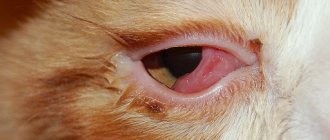Many people think that ticks can only bite a person or a dog, without posing a danger to the cat family. This is not true; according to statistics, cats suffer from tick bites and develop complications much less frequently, but the course of the disease, diagnosis and treatment are more difficult. Even domestic cats require special attention, since the parasite can enter the house through shoes or on human clothing.
Ticks are especially active from March to November; they can be found in grass or bushes, in city parks, and forests. Parasites pose a danger to walking animals, but even if the animal does not leave the house or apartment, the risk of finding a parasite in a cat is not so small.
What to do if your cat is bitten by a tick
If a cat is bitten by a tick, it is necessary to determine its type, of which there are more than 1000: dust ticks, ear ticks, scabies, etc. Ixodid ticks are considered the most dangerous for cats, as they are carriers of pathogens of many diseases.
It is necessary to examine the surface of the skin to determine the extent of its penetration. It is advisable if a specialist removes the parasite, since there is a risk of leaving part of the head under the skin. Also, when the insect moves strongly, the spread of infection increases.
Most often, bloodsuckers choose to bite the groin area, behind the hind legs, ears, stomach and armpit. An attached parasite is visible to the naked eye; immediately after detection, it is advisable to isolate the cat from children, take it to the veterinarian, or try to get rid of the insect yourself.
If a cat is bitten by a tick, then at this moment the animal does not experience pain or discomfort because upon penetration the parasite releases pain-relieving enzymes. Therefore, during the active months of parasite reproduction, you should regularly examine your cat; you can run a comb against the grain and feel the vulnerable spots.
Symptoms of a bite in cats
Symptoms of a tick bite in cats do not appear immediately after detection; the animal behaves calmly, has good appetite and sleep, and the cat does not feel pain, since the parasite uses pain-relieving enzymes during its introduction.
After it has been removed from the skin, it is necessary to monitor the condition of the pet. In case of infection and infection enters the bloodstream, the disease can begin to manifest itself only after a few weeks - the incubation period of infectious diseases.
Symptoms of a tick bite in a cat that should alert you:
- urine has turned pink;
- cough, heavy breathing;
- paleness of the nasal mucous membranes;
- vomiting, bowel dysfunction;
- signs of dehydration;
- sudden weight loss;
- loss of appetite or complete refusal;
- lethargy, lack of interest in the environment;
- heat.
If one or more symptoms occur, you should contact your veterinarian to preserve the health and life of your pet.
Drugs and medications
Localized forms with complications and generalized forms are treated comprehensively. Medicines are selected individually, taking into account concomitant diseases and the condition of the predator.
In case of infection with D. cati and D. gatoi, use the following treatment regimen:
- Amitraz 0.25%. The oil solution is applied to the affected areas once a day every 3 days. Course 4-6 weeks.
- Invec spray is applied to the affected areas. Treat 2-4 times with an interval of 3-5 days.
- Doramectin orally once a day at a dosage of 40-60 mg per kg of body weight. Therapy is carried out for no more than a month.
- Antiparasitic drugs for parenteral administration (s.c.): Dectomax, Baymek, Cydectin.
- Antibacterial drugs Betamox (active ingredient amoxicillin), Kanamycin (amikacin), Ciprovet drops (ciprofloxacin).
Since the fundamental ethological factor is weakened immunity, biogenic stimulants are prescribed: Gamavit, Baksin.
Consequences of a bite
Are ticks dangerous for cats? The parasite's bite itself does not threaten the health of the pet; the danger lies in the pathogens that can get from it to the animal through the bite. The Ixodid tick can cause the development of diseases such as piroplasmosis, hemorrhagic fever, typhus and encephalitis, and borreliosis.
If treatment is not started on time, the infection can affect many body systems and internal organs of your furry friend.
If a cat is bitten by a tick, the consequences, symptoms and treatment depend on the type of infection. Some diseases only affect the cat’s immune system, it becomes lethargic and apathetic, but treatment in this case is 95% effective. Other diseases may not respond to treatment and lead to the death of the pet.
What to do at home if you are bitten
If the bloodsucker has not burrowed into the pet’s skin and it is found on the fur or in the place where the cat sleeps, then it is necessary to inspect the skin. Using a comb, you need to comb the animal against the fur, push it apart with your hands and inspect the skin. Favorite places for parasites to invade are the armpits, hind legs, stomach and groin. If a bite is detected, it is necessary to treat the wound or take it to a veterinary hospital; you should monitor the cat’s health for several weeks; if deterioration occurs, you should consult a doctor.
You can get rid of the parasite as follows:
- Wear gloves on your hands, and upon completion of all manipulations, carefully perform hygiene.
- To prevent the infection from spreading faster, do not lubricate the area around the tick with oil.
- You should not pull the parasite, this will lead to further penetration of the insect's head and the spread of infection.
- The tick must be removed completely without damaging it.
- You can remove the insect using thread or tweezers. You should grab the body of the parasite and pull it out gently and without sudden movements.
- If, however, part of the tick’s head remains in the skin, there is no need to worry too much, since the cat’s body can independently reject the remaining body. This often leads to the development of a small abscess, which can be prevented by contacting a veterinarian.
Treatment is prescribed only by a veterinarian based on the test results and existing symptoms; usually, antibiotic therapy cannot be avoided. You are allowed to treat the bite site yourself at home using antiseptic drugs, with the exception of iodine and brilliant green.
Ixodid ticks in cats
A tick bite that carries piroplasmosis or encephalitis does not pose a danger to a cat, but other more dangerous diseases can develop, such as theileriosis, tularemia and hemobartonellosis. Ixodid ticks are one of the most famous types of parasites, common in many climatic zones.
Symptoms and consequences have different characteristics - it all depends on the type of pathogen. Each disease has a distinctive clinical picture and incubation period:
- Hemobartonellosis. This infectious disease causes anemia only in cats; the disease is not dangerous for humans and dogs. The infection, spreading throughout the body, settles in the lymph nodes, bone marrow, liver and spleen. The incubation period ranges from several days to three weeks. The manifestation of symptoms depends on the animal’s immune defense; with weak immunity, the disease becomes severe. The disease manifests itself in decreased appetite, rapid heartbeat, lethargy and fading of the cat, the skin is pale or yellow, and the temperature is elevated. Only an urgent visit to the veterinarian can save the life of a pet.
- Tularemia. The pathogen enters the lymph nodes through the cat’s blood, developing a purulent inflammatory process. After some time, the lesions are opened, which leads to even greater blood infection. The disease affects the spleen, liver and lungs. Tularemia manifests itself in the form of lethargy of the animal, the skin becomes yellowish, small ulcerations form on the mucous surfaces, the lymph nodes in the neck are enlarged, the animal experiences malaise and fever. If treatment is not started in time, the cat dies in a matter of time, one of the causes of death is necrosis of the tissues of the spleen, lungs and liver. This disease is dangerous to humans and is transmitted through contact.
- Theileriosis. The infection, entering the animal's blood, multiplies in the spleen, lungs, liver and lymph nodes, causing severe damage. The first symptoms appear 1–3 weeks after the tick bite: the cat becomes lethargic, the temperature rises, the skin is yellow, the cat looks thin and apathetic, and the appetite disappears. Upon examination, the veterinarian notes an increase in internal organs. The disease is difficult for cats to tolerate, and only timely treatment can save the animal’s life.
To prevent such consequences after an ixodid tick bite, it is necessary to carry out prevention, constant examination of the animal and timely treatment.
Main types of demodicosis
Depending on which species of tick causes the disease, the disease has a contagious (Demodex gatoi) or non-contagious (Demodex cati) form.
Types of pathology by degree of localization:
- localized - one area of the animal’s body is affected, sometimes several areas are affected, but there are no signs of the disease on the paws;
- generalized - several areas on the animal’s body are affected, and the cat’s paws are involved in the process - this form is more severe than localized. Veterinarians recommend sterilizing pets who have had this form due to the high risk of inheriting the subcutaneous mite.
Can a tick fall off on its own from a cat?
Ticks and cats are a hot topic for the hot season, since it is in the summer that animals most often suffer from parasite bites. Having discovered a parasite attached to a pet, many people have a question: can the tick fall off on its own?
It is better not to wait until it detaches itself; it is necessary to remove the insect as soon as possible, since the longer the parasite is under the skin, the more infection will enter the blood. In some cases, when the tick is completely saturated with blood, it is able to fall off on its own.
Can a cat die from a tick bite?
Are ticks dangerous for cats? The parasite itself does not pose a danger to the animal if it is not the causative agent of any disease.
Can a cat die from a tick bite? With timely treatment and treatment, the animal’s health is restored without complications. If urgent measures are not taken, the animal’s body weakens in a matter of time, exhaustion and disruption of the functioning of internal organs are observed, which leads to serious consequences, including death.
Prevention
The main prevention is acaricidal agents and essential oils. When choosing preventative agents, it is important to take into account the weight and age of the individual.
Sprays
These products are sprayed onto the animal's fur. It contains chemical components that repel ticks. When handling, it is important to close the cat's eyes, ears and mouth. The main drugs are:
- buyer;
- hartz;
- agrovet protection.
They can be purchased at a veterinary pharmacy or clinic.
Collars
They are soaked in acaricides or essential oils to prevent bites. These collars are worn for a certain period of time, after which their effectiveness decreases to zero.
Drops on the withers
This method can be called the most effective. Drops of the product are applied to the cat’s withers. Active substances accumulate in the pores and glands and are distributed with secretions throughout the body. The most popular of them are Bars, Bayer or Hartz.
Drops on the withers against ticks
Are ticks on a cat dangerous for humans?
If it has already been saturated with cat blood, then it poses no danger to the human body. It is worth remembering that the parasite cannot infect a cat with encephalitis, while this disease is very dangerous for humans.
Having discovered a tick on an animal, it is possible that there may be several such parasites on the pet, in which case there is a risk that the insect will move onto a person’s skin and bite him. Therefore, it is important to examine your pet for parasites while wearing protective gloves.
Folk remedies
In parallel with traditional ones, alternative methods of therapy are used. folk recipes against askariasis:
- Infusion of leather mackerel. 1 tablespoon of dry herb is poured into about 5 liters of boiling water and set aside until it cools completely. The strained solution is diluted with 0.5 liters of water and the pet is bathed. The plant has a bactericidal effect and promotes rapid healing of wounds.
- Wounds are treated with calendula tincture. To avoid side effects, it is better to buy the product at a pharmacy and use it according to the instructions.
- Treatment of wounds with concentrated chamomile infusion. To prepare it, 100 dry plants are poured with boiling water. The cooled infusion is filtered.
Be sure to read:
How to deworm a cat: when to do it, how often, the best drugs and folk remedies
It is forbidden to treat leather with kerosene. The substance causes severe intoxication.











